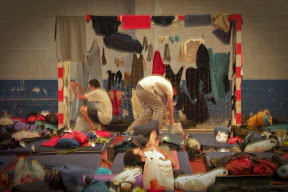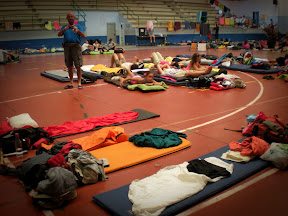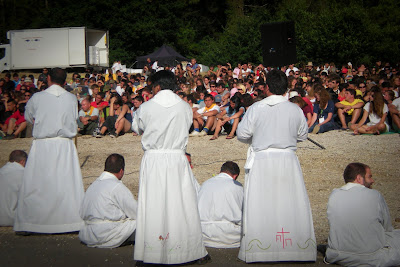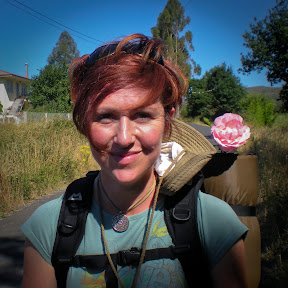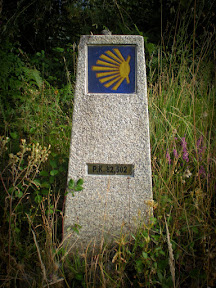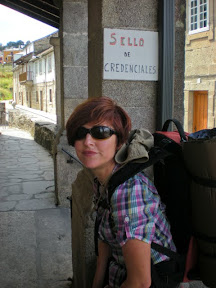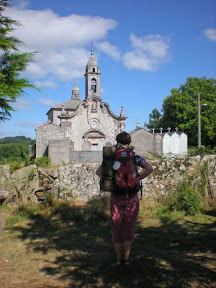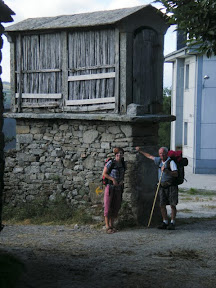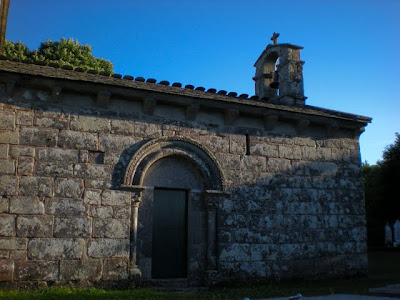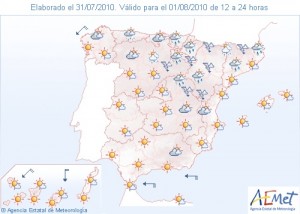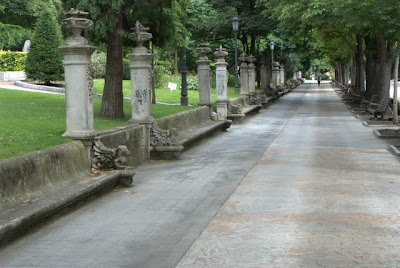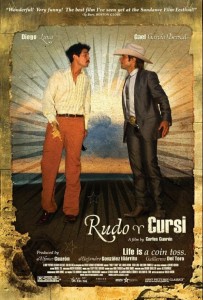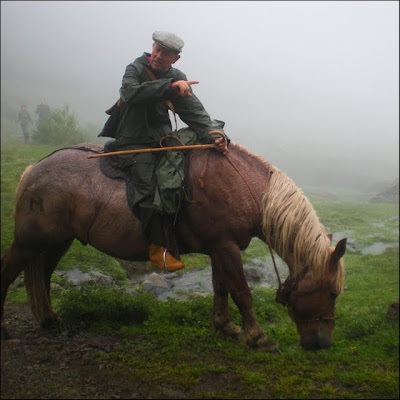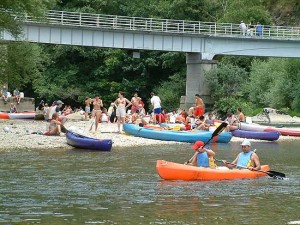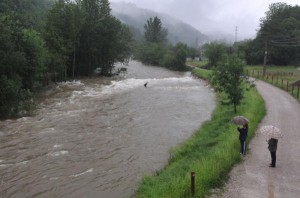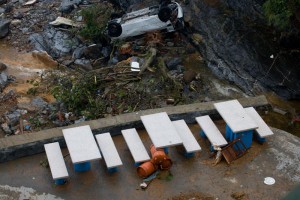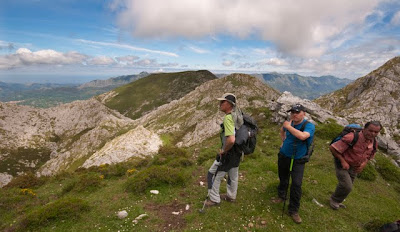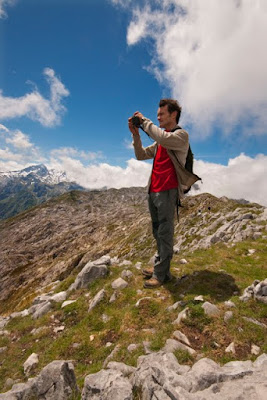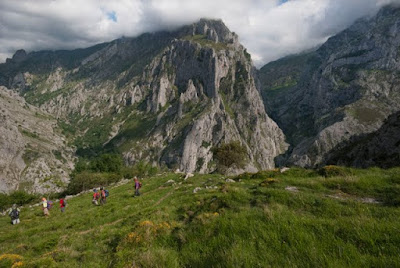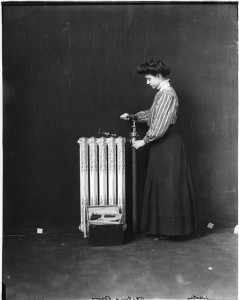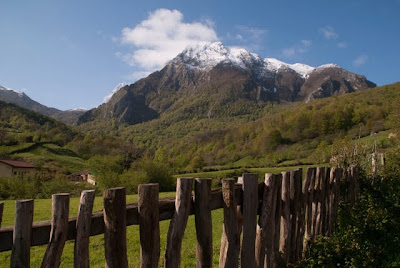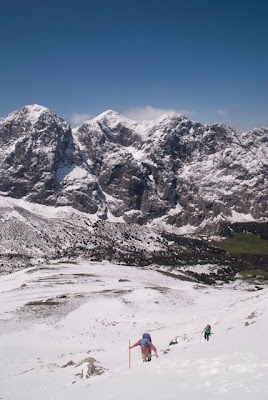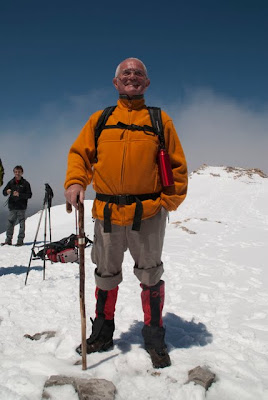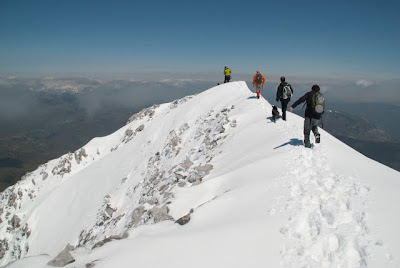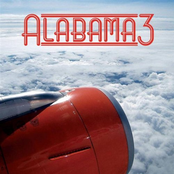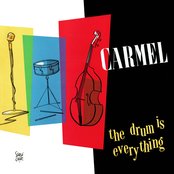Camino Primitivo, part 11: Melide to Pedrouzo (Arca) 34km
So 34km was not the plan for today. It just sort of happened by accident.
The first stirrings in the sports hall were at 4:30am. I slept on, oblivious, but Liz and Julio, earplugless, were treated to the noises of those early risers aiming for a bed in the next albergue. We got our stuff together at 7:30 and went in search of breakfast. In the bar, over coffee, toast and jam the waiter asked us if we were coming or going. People were arriving that early, no wonder the albergues were full. As we strolled along the cobbled streets of Melide, the sun was just lighting the tops of the buildings. A big procession of pilgrims, led by a man carrying a tall thin crucifix went past.
It felt uttery different, walking as part of a stream of people. We overtook some, were overtaken by others, moved to the side of the path to let the bike riders go by. We caught up to the big group as they waited for their members to all get the credentials stamped in a church. We passed smaller groups led by priests doing the rosary as they walked. This was no longer our camino, the lonely primitivo, the solo walking from bar to bar, this was proper pilgrimming, or so I thought, until I noticed they only had tiny daysacks.
We heard more international voices too, passing a French couple with a baby in a backpack singing children’s songs as they went. We heard German and Dutch, Portugese and Italian. Not so much English though. We stopped for coffee after a couple of hours of walking on dusty paths through eucalyptus woods. The barman was fairly chatty for a Galician. He talked about the unreliable distance markers and how most people don’t really do a proper pilgrimage, for every 100km he reckoned the majority walk less than 20km.
After 14.5km we entered Azúa, our original destination, where we thought we’d book in the albergue, or the sports hall, and let our feet recover. Long days in the heat mean my feet suffer. The soles and the tips of my smaller toes especially. I was limping a little, not like some of the walking wounded we had seen in the sports hall the night before but still, enough to want an easy day. We arrived at 11am and the queue for the Albergue stretched a long way. We counted, 46 places in the building and 70 pilgrims waiting. Julio muttered something about los chinos, refering to some korean walkers at the head of the queue, and how they must have walked through the night to get there that early. So? We said.
He went off to see about the sports hall and came back saying that the youth pilgrimmage had booked the whole place but they were opening another hall at 4pm if we wanted to wait. We called a few hotels but they were all full too. Then we had a round of What shall we do? What do you want to do? I don’t mind, what would you prefer? Well I’m happy to walk or to stay, what would you like to do? Until Liz took the lead and actually stated a preference. Let’s keep going. How far is it?
So we had a quick beer and set off. We needed the beer because there were another 19km.
More dusty paths and eucalyptus. And corn, lots of corn fields. We stopped at small walkers bar and had bacon and egg butties for lunch and watched a group on horseback go by. The group leader wore a bright yellow t shirt, a wide back support like a cummerbund, and a wide-brimmed hat like some US cavalry officer. The two others following were hatless and red.
Another 6km and we stopped for a coffee, because this is meant to be enjoyable after all.
In the shadows of eucalyptus trees we stopped at Santa Irene to confirm that the albegues there were full. They were. So we decided to call ahead to Santiago and book rooms for the Friday night, becuase we were a day ahead of schedule. We had picked up a flyer for a small hotel from the floor, luckily dropped or lost by another pilgrim (all of our numbers were in the lost guide book) and they had room so we instantly felt a little better.
We walked into Pedrouzo (confusingly it also seems to be called Arca) at 7 and on tired legs walked up to the sports centre. The youth were all in the outdoor football pitch and we were directed to the sports hall where they apologised for not having mattresses. No bother, thanks to thermarests. The sports hall was hot, it looked like a tidy, non-screwed-up version of the superdome post-Katrina. We bagged a spot and unfurled.
Beds sorted, we went out for food, passing the youth gathering on a hill for what looked like a hectoring homily from the local bishop as part of an open air mass, becuase that’s what young people need, advice about marriage and relationships from a supposedly celibate sixy-year old. We followed the directions from the lady at the pharmacy (doing a roaring trade in Compeed) to a place that did good octopus. She was spot on. They did fantastic octopus, accompanied by a really good crisp white wine.
Back at the field hospital (lots of limpers, foot inspections, saddle sores) I made my buff into a blindfold, put in the earplugs and dozed off.
Si alguien pudiera hacer unas correcciones si he cometido errores grandes estaría agradecido Pues, el plan de hoy no era 34km, lo pasó sin querer.
La gente en el polideportivo empezaron levantarse a las 4:30 de la mañana. Sigue durmiendo pero Liz y Julio, sin tapones, tuvieron que escuchar a los ruidos de los que se levantaban pronto con la intención de coger sitio en el próximo albergue. Arreglamos nuestras cosas a las 7:30 y salimos en busca del desayuno. En el bar, mientras tomábamos el café y pan tostado con mermelada, el camarero nos preguntó si veníamos o íbamos, la gente llegaba tan temprano, no me extrañó que los albergues estaban a tope. El sol iluminaba las partes mas altas de los techos mientras caminamos tranquilamente por las calles adoquinadas de Melide. Un gran desfile de los peregrinos nos pasó encabezado por un hombre que llevaba un crucifijo alto y fino.
Caminar con un flujo de gente era distinto. Los adelantamos algunos, nos adelantaron otros, los dejamos pasar algunos en bici. Alcanzamos el grupo grande mientras esperaban para el cuño en una iglesia. Pasamos unos grupos mas pequeños encabezados por curas, rezaban el rosario mientras caminaban. Ya no era nuestro camino, el primitivo aislado, en lo que caminábamos solos de un bar a otro, esto era una peregrinación correcto, o eso pensaba yo hasta que los vi que llevaban pequeñas mochilas suficiente para un día solo.
Oímos voces mas internacionales también, pasamos una pareja francesa que llevaban un bebe en la mochila, cantaban canciones de niños mientras caminaban. Oímos el alemán, el holandés, el portugués y el italiano, pero no mucho del inglés. Después de un par de horas caminando por bosques de eucalipto hicimos una parada para tomar un cafe. El del bar hablaba mucho por ser gallego, el hablaba sobre los mojones poco fiables, y como la mayoría de la gente no hace correctamente la peregrinación, nos dijo que para cada 100km la mayoría camina menos de 20km. Después de 14,5km entramos en Azúa, nuestro destino original, en donde pensábamos que nos quedaríamos en el albergue o el polideportivo y los dejaríamos recuperar los pies. Sufren mis pies con los días largos, sobre todo las plantas y los dedos mas pequeños. Yo cojeaba un poco, no tanto como algunos de “los heridos ambulatorios” pero suficientemente para desear un día fácil. Llegamos a las 11h y la cola para el albergue ya era larga, los contamos 70 peregrinos esperando a las 46 plazas en el albergue. Julio habló entre dientes algo sobre los chinos en referencia a unos caminantes coreanos encabezando la cola, dijo que deben haber andado por la noche para llegar tan pronto. ¿Y? lo dijimos.
Se fue para obtener información sobre el polideportivo y volvió diciendo que los peregrinos jóvenes habían reservado todos los sitios pero iban a abrir otro pabellón a las 16h si querríamos esperar. Llamamos a algunos pensiones pero estaban también completos. Así que nos dijimos entre nosotros ¿Qué hacemos? ¿Qué quieres hacer tú? ¿Me da igual, qué prefieres tú? ¿No importa si caminemos o nos quedemos, qué quieres hacer tú? Hasta que Liz tomó la iniciativa y nos dijo ¡Vamos! ¿son cuantos kilómetros?
Así que tomamos unas cañas y nos marchamos. Las cañas eran necesarias porque nos quedaban unos 19km.
Pasamos por mas caminos polvorosos y bosques de eucalipto, y maíz, muchos campos de maíz. Nos paramos en un bar de peregrinos y comimos bocadillos de lomo y huevos fritos, miramos a un grupo en caballo que nos pasaban. El líder del grupo llevaba una camiseta amarilla viva, una faja lumbar grande y un sombrero como los oficiales de la antigua caballería estadounidense. Los dos siguientes no llevaban sombreros y tenían cabezas rojas.
Después de 6km mas tomamos un café porque después de todo este camino debería ser divertido.
Entre las sombras de los eucaliptos nos paramos en Santa Irene para confirmar que los albergues allí estaban completos. Estaban así entonces decidimos llamar a Santiago y reservar unas habitaciones para la noche del viernes porque estábamos adelantos del programa por un día. Habíamos encontrado un folleto de una pensión en el suelo, dejado allí por suerte, por otro peregrino (todos nuestros números del teléfono habían estado en la guía perdida). Había sitio en la pensión así que nos sentimos inmediatamente un poco mas animados.
Entramos caminando en Pedrouzo (aparentemente se llama Arca también) a las 19h y subimos con las piernas cansadas hasta el polideportivo. Los jóvenes se quedaban en un pabellón al aire libre y nos indicaron al polideportivo donde se disculparon con nosotros por no tener colchonetas disponibles. No nos importaba gracias a los “Thermarest”. Hacía un calor adentro el polideportivo, parecía si fuese una versión no jodida del “Superdome” después del huracán Katrina. Cogimos nuestro sitio y desplegamos los sacos.
Con camas arregladas, salimos para cenar, pasamos los jóvenes que estaban reuniendo en un montículo para recibir una homilía intimidada (porque esta es lo que necesitan los jóvenes, los consejos sobre el matrimonio y las relaciones de un hombre célibe que tiene 60 años). Seguimos las direcciones de la señora de la farmacia (que hacía su agosto vender Compeed) hasta un lugar en que cocinan un buen pulpo, tuvo razón, la señora, el pulpo era optimo y era acompañado por un vino blanco seco.
De nuevo en el “hospital de campaña” (muchos cojos, inspecciones de pies, lesiones de sillín) se convertí mi buff en una venda, me puse los tapones y me quedé frito.
Tags: camino primitivo, galicia, julio, Spanish and English, walking
Posted in spain Comments Off



